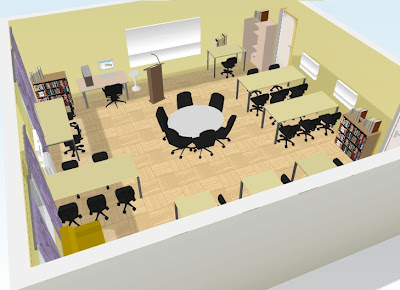Classroom Layout and Behavior
on Monday, 05 October 2015.
picture from http://processofliving.com/2013/01/23/21st-century-classroom-design/A piece from my full length article in SEEN (southeast education network) winter edition titled: Designing Modern Classrooms, Step 2: The Modern Classroom As It Influences Learning and Behavior
Contemporary classrooms should be active spaces. Meaning that instructors focus class time on collaborative and practical application exercises as well as individual work or lecture centered periods. An active learning room can be designed as if there is no front or back of the room; round work tables or movable desks and tables oriented in circles or semi-circles are placed throughout the room. White boards and displays (or projectors and screens) can be situated on the outside walls next to the group work tables. Each area should have connectivity and power for laptops or tablets This layout allows smaller groups of students to work together on course curriculum and help each other through problem solving and comprehension. The technology and ease of connectivity offer immediate research opportunities, sharing information between students and instructor.
Being able to bring chairs or tables together creates an environment that is more open to discussion and interaction. This flexibility changes the dynamic of the students and teacher. It creates a welcoming environment to share ideas...
As mentioned, learning space layout will also affect student interaction not only among peers but also interaction with teachers. More active discussions and the ability to share ideas, challenges and solutions are effective and necessary classroom tools. A variety of journals have provided support regarding the behavioral significance of collaborative and interactive learning including:
• Research from the Proceedings of the National Academy of Sciences (www.pnas.org) indicates that “active learning increases student performance in science, technology, engineering, and mathematics…Failure rates under traditional lecturing increase by 55% over the rates observed under active learning.”
• Collaboration affects personality: increases openness, conscientiousness, agreeableness, trust, interactivity and stability
• Team-based learning prepares students for modern workforce
• Teamwork strengthens community bonds, socialization and communication
• Collaboration increases productivity and efficiency
• Carnegie Mellon University (http://dl.acm.org/citation.cfm?id=2724681) found “students doing more activities learn more than students watching more videos or reading more pages”
Therefore, not only are room layout and equipment affecting student learning but also providing much needed practical, behavioral and “real world” skills useful in today’s workplace.
